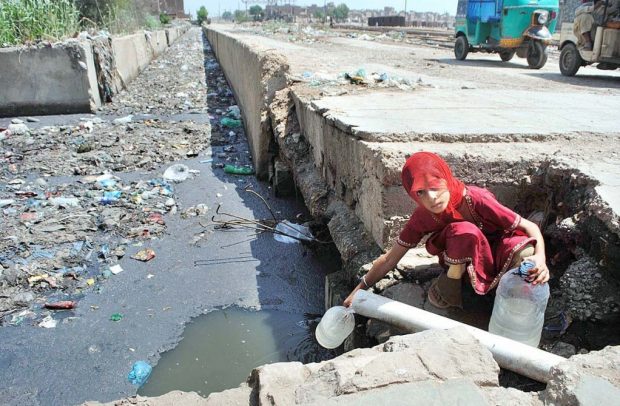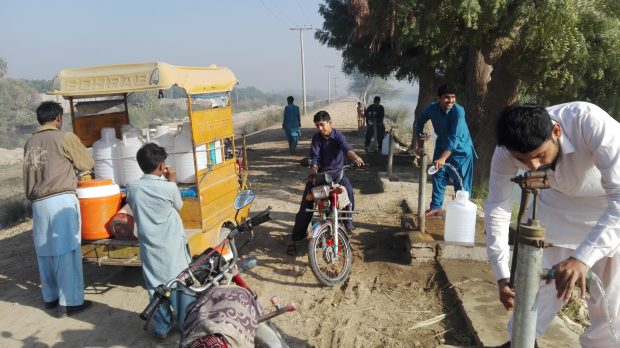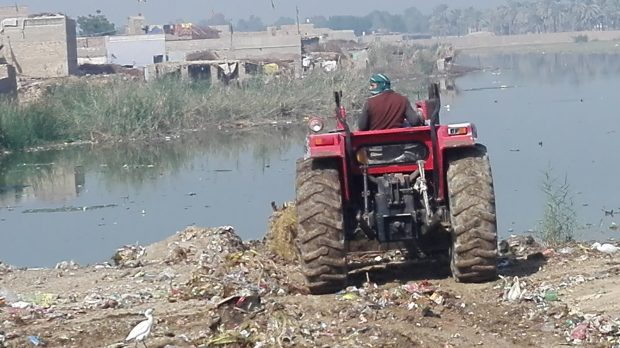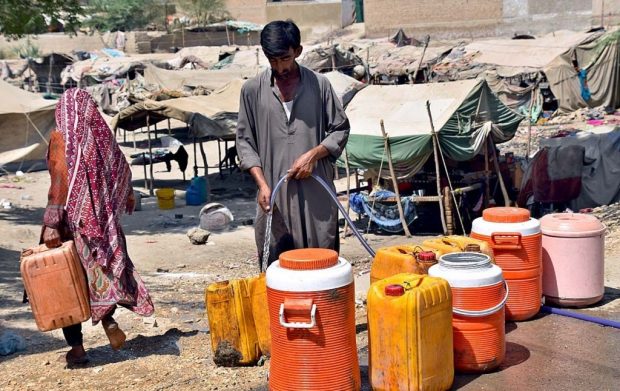Pakistan – Where People Consume Poisonous Water

A child scoops up water from a contaminated source in Pakistan
It was a frosty and misty Sunday morning of December 2017 when I noticed several people of varying ages riding bikes and three-wheeler Chinese rickshaws, locally called “Chingchi”, loaded with empty plastic cans. They all headed to a British-era canal flowing north to south in the east of town.
“They all are going to the canal to fetch water,” my nephew told before I even ask, as he himself kick-starts his bike holding a plastic can. “All the residents of the town have either handpumps or electric pumping machines installed in their homes, but they have stopped using the water for drinking. According to laboratory tests, the subsoil water running through town has turned arsenic,” he said.
“So, they consume untreated and contaminated canal water,” I asked.
“No uncle. Philanthropists have installed six handpumps at the bank of the canal where the subsoil water has been found comparatively safe for drinking,” he replied.
It was my hometown: Bhiria City in Naushehro Feroze, a district in the central part of Sindh province of Pakistan. I had visited my hometown after a long time and hadn’t known the change in situation the townspeople faced.
 Being curious, I followed them to the canal bank where people were hand-pumping water into their cans.
Being curious, I followed them to the canal bank where people were hand-pumping water into their cans.
“We have come early in the morning, as people come here in throngs to fetch water during the day,” a teenager said whilst manually operating the pump.
“You can find handpumps everywhere in all the towns of Naushehro Feroze and other districts of this province because apart from the water from these pumps, the underground water has become poisonous,” another person waiting explained.
It was a painful sight for me. I remembered my childhood days, where there used to be small wells in each house and big wells situated around the neighborhood. The water had always been pure and of high quality; cold in summer, and warm in the winter. Over time, wells were replaced with handpumps and electric motor pumps. And for some reason, the water had also become smelly with increased salinity levels.
I contacted Mr. Majid Soomro, a civil engineer and resident of Bhiria town, who said, “You will be surprised to know that the town of twenty thousand people has no working water-supply system even in the 21st century,” adding, “The government had built a water supply system with an overhead tank; they laid pipelines some thirty years ago, but it never functioned.” The whole system had become dilapidated.
To shed light on the grave situation and find the reason behind the arsenic-contaminated water, I further contacted Ghulam Rasool Keerio, a retired Conservator of Forests and Consultant on Environment, Forestry, and Landscaping—also a resident of a nearby village. “You know, chemical fertilizer has been used on agricultural fields since decades ago. This has adversely affected the subsoil water,” he said.
“Moreover, there is no proper sewage system in the rural areas. You can see big ponds and lakes contaminated with sewage water surrounding the towns—also affecting the water,” Keerio continued, adding that the situation was worsened to due to lack of rain that increased the salinity of water in underground systems.
“In most of the cities and towns, sewage water is discharged into the same canals from which water is supplied to the citizens,”—he referred to the issue recently taken up by the Supreme Court of Pakistan after a lawyer, Shajab Osto, filed a petition against the Sindh government for its inability to insuring safe drinking water.
Myself being a journalist, I was well aware of the failed water supply and sanitation system in my country. I can still recall a report filed by a non-government organization around two and half decades back; it had said all the underground water in Sindh had turned arsenic. The NGO had called for urgent measures to be taken in control of the alarming situation.
Even after that, after all those years, official documents today paint a very rosy picture of water supply and the area’s sewage system. According to government data Pakistan gave to the UN, more than 90 percent of the 200 million population have access to drinkable water and over 72 percent are provided with effective sewage and sanitation facilities—contrary to the fact that more than 50 percent of the population is devoid of safe water and sewage facilities.
The fact was admitted recently in a report prepared by Sindh government to submit to the Supreme Court, who had summoned the Chief Minister of Sindh province Syed Murad Ali Shah to respond about grave situation. According to this report provincial Public Health Engineering Department provides drinking water to 16.567 million rural populations, which is 53 percent while its drainage schemes cover 12.513 million people, which constitutes 40 percent of the rural population.
 The fact was acknowledged recently in a report made by Sindh government which was submitted to the Supreme Court. Officials summoned the Chief Minister of Sindh province Syed Murad Ali Shah to respond to the grave situation. And as revealed by that report, the provincial Public Health Engineering Department provides drinking water to 17 million of the rural population (53%) while its drainage plans cover only 13 million people—constituting 40 percent of the rural population.
The fact was acknowledged recently in a report made by Sindh government which was submitted to the Supreme Court. Officials summoned the Chief Minister of Sindh province Syed Murad Ali Shah to respond to the grave situation. And as revealed by that report, the provincial Public Health Engineering Department provides drinking water to 17 million of the rural population (53%) while its drainage plans cover only 13 million people—constituting 40 percent of the rural population.
Of course, the big cities have their own water supply and sewage systems, but urban populations, too, face similar problems with their pipes that often carry clean water from their own pipes with the contaminated water of other obsolete pipes.
This same report has identified 755 points where the sewage water of the cities and towns is discharged into canals and such highly contaminated water is given out as drinking water.
The hearing of the petition in the apex court continues for which the Chief Minister of Sindh has prepared a 12-page report. The petition made by Lawyer Osto has jolted the entire government since he had also played videos that clearly revealed discharge of sewage water into clean-water canals—playing them in front of the Chief Minister. The Minister, on that day, conceded the fact that a similar situation can be seen in other provinces.
During one of the hearings, it was said that citizens have to pay too much of their income to buy bottled water to save them from water from national pipes. Another comment was made by a lawyer who remarked that “the government is focused more on setting up cellphone companies in Pakistan rather than on the provision of safe drinking water for its citizens.”
















































